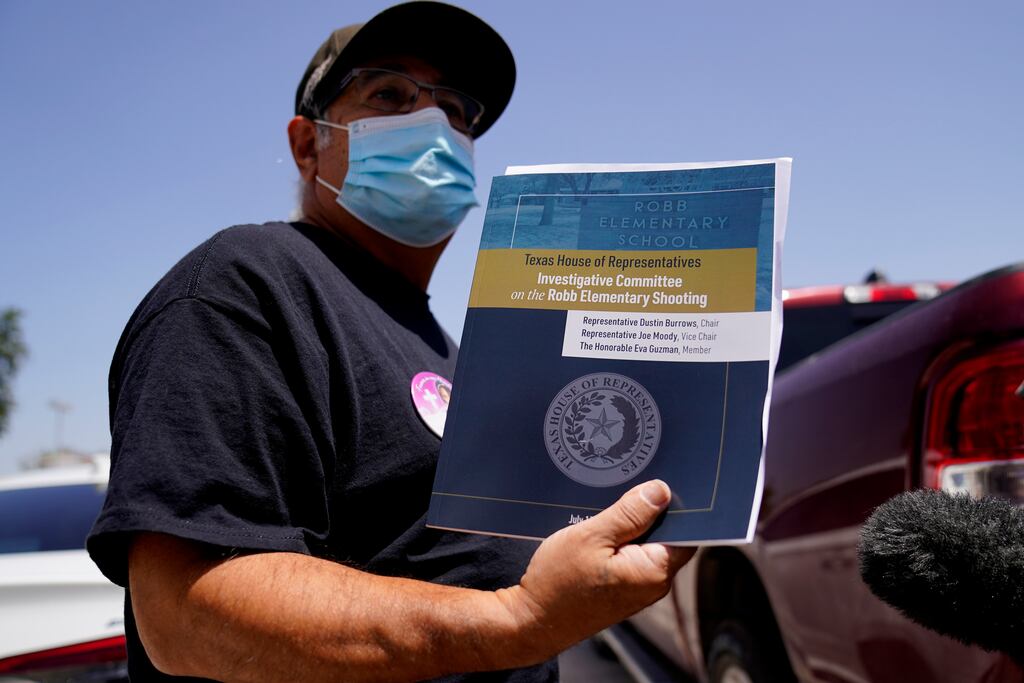It is plausible that some victims of the Uvalde school shooting in Texas could have survived if they had not had to wait 73 minutes for rescue, the first report into the incident in May has concluded.
However, the report drawn up by a committee of the House of Representatives in Texas, released on Sunday, said it was likely that most of those who died were killed immediately “during the attacker’s initial barrage of gunfire”.
Nineteen school children and two teachers were murdered when a 18-year-old gunman attacked the Robb elementary school in Uvalde in Texas armed with an assault rifle on May 24th.
The preliminary report of the committee pointed to inadequate precautions taken in the school as well as “systemic failures and egregiously poor decision making by those involved in responding to the attack.
READ MORE
The report found that there was “an overall lackadaisical approach by law enforcement at the scene”.
After initially arriving at the school and coming under fire from the gunman, police waited for over an hour outside the classrooms while some children were trapped inside.
The report found that at Robb Elementary school, law enforcement responders failed to adhere to their active shooter training and had failed to prioritise saving the lives of innocent victims over their own safety”.
“The first wave of responders to arrive included the chief of the school district police and the
Commander of the Uvalde police department SWAT team. Despite the immediate presence of local law enforcement leaders, there was an unacceptably long period of time before officers breached the classroom, neutralised the attacker, and began rescue efforts. We do not know at this time whether responders could have saved more lives by shortening that delay.”
“Regardless, law enforcement committed numerous mistakes in violation of current active shooter training.”
The Texas committee report said that one motive that drove the man behind the massacre at Robb Elementary School “was a desire for notoriety and fame”.
It said that in mid-2021, his relationship with his girlfriend had ended. It said she was later interviewed by the FBI and described the attacker as lonely and depressed, constantly teased by friends who called him a “school shooter.” She said he told her repeatedly that he wouldn’t live past eighteen, either because he would commit suicide or simply because he “wouldn’t live long.”
It said the attacker had responded to the break-up by harassing the girl and her friends.
The report said he purchased weapons and ammunition just after he reached his 18th birthday.
“An online retailer shipped 1,740 rounds of 5.56mm 75-grain boat tail hollow point to his doorstep, at a cost of $1,761.50. He ordered a Daniel Defense DDM4 V7 (an AR-15-stle rifle) for shipment to a gun store in Uvalde, at a cost of$2,054.28 (including tax and transfer fee). On May17, 2022, he bought a Smith and Wesson M&P15(also an AR-15-style rifle) at the same store in Uvalde,at a cost of $1,081.42. He returned the next day for375 rounds of M193, a 5.56mm 55-grain round with a full metal jacket. which has a soft core surrounded by a harder metal.”
The report said that “with hindsight” Robb Elementary did not adequately prepare for the risk of an armed intruder on campus.
It said the school’s five-foot tall exterior fence was insufficient to meaningfully impede an intruder.
“While the school had adopted security policies to lock exterior doors and internal classroom doors, there was a regrettable culture of non-compliance by school personnel who frequently propped doors open and deliberately circumvented locks. At a minimum, school administrators and school district police tacitly condoned this behavior as they were aware of these unsafe practices and did not treat them as serious infractions requiring immediate correction. "
“In violation of school policy no one had locked any of the three exterior doors to the west building of Robb Elementary. As a result, the attacker had unimpeded access to enter. Once inside, the attacker continued into the adjoining Rooms 111 and 112, probably through the door to Room 111, and apparently completely unimpeded. Locking the exterior and interior doors ultimately may not have been enough to stop the attacker from entering the building and classrooms. But had school personnel locked the doors as the schools policy required, that could have slowed his progress for a few precious minutes--long enough to receive alerts, hide children, and lock doors; and long enough to give police more opportunity to engage and stop the attacker.”













